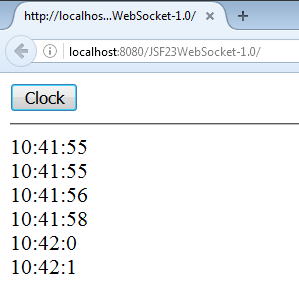JSF 2.3 - The WebSocket Quickstart under Payara Server
Originally published on 17 May 2016
Last updated on 17 May 2016
 by Dominika Tasarz
by Dominika Tasarz
Guest blog by Anghel Leonard ( @anghelleonard ).
Starting with JSF 2.3-m05 we can take advantage of a brand new feature - register a WebSocket push connection in client side. Thanks to the JSF team (especially to Bauke Scholtz (aka BalusC)) this feature is available in today milestone via <f:websocket/> tag.
In this post, let's see a minimal usage of <f:websocket/> tag.
On the JSF page, we need to add the <f:websocket/> tag with its two required attributes:
channel- This isjavax.el.ValueExpressionthat must be evaluated to String and it represents the name of the WebSocket channel. A channel name is restricted to alphanumeric characters, hyphens, underscores and periods. A channel can have multiple open WebSockets, and each of these sockets will receive the same push notification from the server.onmessage- This is javax.el.ValueExpressionthat must be evaluated to String and it represents the a JavaScript listener function that is automatically invoked when a push notification is received from the server.
The signature of the listener function for onmessage is of type:
function fooListener(message, channel, event) {
// message - the message pushed by the server
// channel - the channel name
// event - the raw MessageEvent instance
}
So, a simple <f:websocket/> tag usage will look like this:
<f:websocket channel="clock" onmessage="socketListener" />
<div id="clockId"></div>
<script type="text/javascript">
function socketListener(message, channel, event) {
document.getElementById("clockId").innerHTML += message + "<br/>";
}
</script>
By default, when we start the application, the WebSocket is automatically connected and open. As long as the document is open the WebSocket is open. When the document is unloaded the WebSocket is automatically closed. In the WebSocket is initially successfully connected but the connection is closed as a result of e.g. a network error or server restart, JSF will try to auto-reconnect it at increasing intervals.
Now, let's focus on the server side. Here we have to take into account the push messages mechanism. This mechanism is based on javax.faces.push.PushContextinterface and javax.faces.push.Push API.
First, you need to know that by default the WebSocket is application scoped. This means that the managed bean that can push messages to this web socket must be in application scope (annotated with @ApplicationScope). In this case, the push message can be sent by all users and the application itself.
Furthermore, you have to inject PushContext via @Push annotation on the given channel name in any CDI/container managed artifact. For example:
@Inject
@Push(channel = "clock")
private PushContext push;
Finally, we need to write an action method capable to push messages to WebSocket via PushContext. For example:
public void clockAction(){
Calendar now = Calendar.getInstance();
String time = now.get(Calendar.HOUR_OF_DAY) + ":" +
now.get(Calendar.MINUTE) + ":" +
now.get(Calendar.SECOND);
LOG.log(Level.INFO, "Time: {0}", time);
push.send(time);
}
Let's glue everything together. First, the JSF page:
<h:body>
<h:form>
<h:commandButton value="Clock" action="#{pushBean.clockAction()}">
<f:ajax />
</h:commandButton>
</h:form>
<f:websocket channel="clock" onmessage="socketListener" />
<hr/>
<div id="clockId"></div>
<script type="text/javascript">
function socketListener(message, channel, event) {
document.getElementById("clockId").innerHTML += message + "<br/>";
}
</script>
</h:body>
Next, our simple CDI bean:
@Named
@ApplicationScoped
public class PushBean implements Serializable {
private static final Logger LOG = Logger.getLogger(PushBean.class.getName());
@Inject
@Push(channel = "clock")
private PushContext push;
public void clockAction(){
Calendar now = Calendar.getInstance();
String time = now.get(Calendar.HOUR_OF_DAY) + ":" +
now.get(Calendar.MINUTE) + ":" + now.get(Calendar.SECOND);
LOG.log(Level.INFO, "Time: {0}", time);
push.send(time);
}
}
In order to avoid an error as in figure below (from Payar Server), we need to add a fake endpoint:

As BalusC pointed out, this fake endpoint should look like below:
import javax.websocket.Endpoint;
import javax.websocket.EndpointConfig;
import javax.websocket.Session;
public class FakeEndpoint extends Endpoint {
@Override
public void onOpen(Session session, EndpointConfig config) {
// https://java.net/jira/browse/WEBSOCKET_SPEC-240
}
}
Finally, the m05 requires the following settings in web.xml:
<context-param>
<param-name>javax.faces.ENABLE_CDI_RESOLVER_CHAIN</param-name>
<param-value>true</param-value>
</context-param>
<context-param>
<param-name>javax.faces.ENABLE_WEBSOCKET_ENDPOINT</param-name>
<param-value>true</param-value>
</context-param>

Done! The complete application was tested under Payara Server and it is available here.
Originally published by OmniFaces on the 25th of March: http://www.omnifaces-fans.org/2016/03/jsf-23-websocket-quickstart.html .
Related Posts
The Payara Monthly Catch - March 2025
Published on 31 Mar 2025
by Nastasija Trajanova
0 Comments
Still on Java EE 7/8? Secure Payara Platform Enterprise 4 Lifetime Support Now Before It Ends.
Published on 07 Mar 2025
by Chiara Civardi
0 Comments

